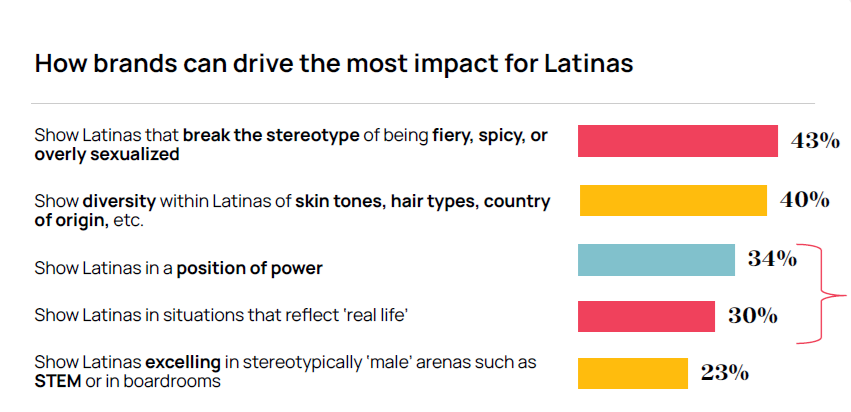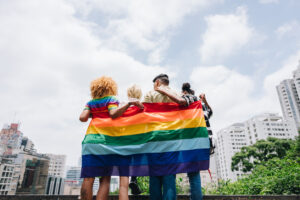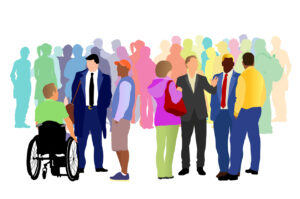By the Numbers: How brands can better represent the growing Latina market
And how to break stereotypes to provide authentic messaging.

Latinas are an increasingly critical demographic of the U.S. population. There are 30 million Hispanic women in the United States, nearly 10% of all people in the country. And 86% of those Latinas report that they are responsible for purchasing decisions in their households.
In other words, your brand needs to court this demographic.
But a new survey from Boden Agency finds that brands still have a long way to go to effectively reach this diverse segment of the population.
And by and large, it found that brands have a long way to go.
“I think that brands are missing the mark,” Sara Garibaldi, president of Boden Agency, told PR Daily. “That’s the biggest takeaway. Frankly, we heard loud and clear that Latinas continue to feel that they’re underrepresented.”
Boden’s survey gathered responses from more than 500 Latinas, ranging from Gen Z to Boomers. It also included in-depth qualitative interviews with six Latina women.
Here’s what the survey revealed about this group – and about how brands can better serve them.
The stereotype problem
The survey revealed a dichotomy: Latinas feel they are often reduced to stereotypes in marketing and the media. A third of respondents said that the media does not accurately depict Latinas, and 43% said they’re tired of seeing characters who are “fiery, spicy or overly sexualized.”
And they’re holding brands accountable as well: 81% said brands have a responsibility to accurately depict Latinas, and that this role has an impact on the real world, with nearly two-thirds believing that how Latinas are depicted in marketing shapes how the group is perceived.
But while the outside world may be conditioned to see Latina characters who are “spicy” and outspoken, there’s often an opposite problem within the community itself.
Forty-five percent of respondents feel that society expects them to remain silent. How does that square with the stereotype of the outspoken, brazen woman?
Garibaldi says they come from different places: an internal expectation and an external perception.
Within the Latino community, the phrase “calladita te ves más bonita” – you look prettier when you’re quiet – that often puts pressure on women to, well, look pretty and be quiet.
But many are no longer content with that status quo.
“The way that marketers can help engage with Latinas in an authentic way is understanding that internally, some of us have dealt with the calladita culture and seek campaigns that empower Latinas, elevate Latinas, help this new generation that’s really pushing against some of these old generational norms that we grew up with and help them break through,” Garibaldi said.
Rather than leaning into either the fiery temptress stereotypes or the expectations of a silent shadow, Garibaldi recommends looking at who Latinas really are today: leaders in STEM, powerful athletes and entrepreneurs.
“Brands are empowered to break stereotypes in the type of campaigns that they’re putting out there,” Garibaldi said.
What brands can do
Nearly half of Latinas surveyed don’t feel seen at all in marketing campaigns, the survey found, while 71% feel it’s important those brands showcase Hispanic role models.
In particular, respondents want to see people in campaigns that reflect the diversity of Latinas. Latinas are not a race – they’re a culture and a set of national origins. Latinas can be white, Black and everything in between. But Garibaldi says there’s long been an assumption in the U.S. that there’s one “look” that can represent the vast diversity of Latinas.

“Because the Mexican community in the US is the largest Latina group, there’s an assumption that, ‘oh, if you approach them through the Mexican culture, you reach all of them.’ But there’s millions of us that are not necessarily Mexicans,” Garibaldi pointed out.
There is a huge opportunity to depict Latinas as the diverse, vibrant group they are. It takes research, data and a diverse team to help reach these audiences in compelling ways.
“I don’t want to say it’s so easy to get it right, because it’s not easy,” Garibaldi said. “It’s nuanced, it’s intricate. You need to understand them, but there’s so much opportunity to truly make a difference. One thing that this study showed is that there’s such ripe territory for brands to come in, no matter what industry you’re in, and make an impact.”
Allison Carter is editor-in-chief of PR Daily. Follow her on Twitter or LinkedIn.







